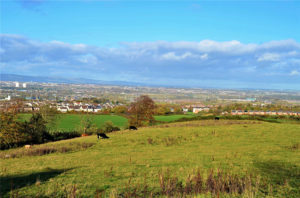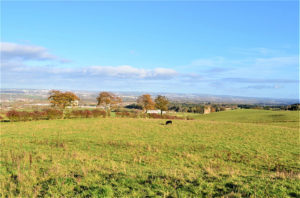When it comes to selling farmland, the sum is proving to be greater than the parts.
In the last 12 months more than 60 farms totaling in excess of 20,000 acres with a value in excess of £65 million were sold by Galbraith in Scotland.
A number of these farms were sold in lots, with the farmhouse, buildings and an area of amenity land packaged together as one lot, leaving the remaining farmland sold either as another larger lot, or as several smaller lots.
Duncan Barrie, who leads the Galbraith farm sales team from the firm’s national farm sales centre in Stirling, said: ‘Marketing a farm in a number of suitably packaged lots can provide a variety of benefits.

Lochwood Farm in Gartcosh
‘However not every farm will be suitable to be sub-divided and careful consideration needs to be made in each and every sale. Through dividing up the farm into smaller chunks both by land area and in terms of an asking price, we automatically expose the holding to a greater number of individual buyers each with varying levels of affordability.
‘In some instances, a buyer may not necessarily wish to take on a farming unit, which is equipped with multiple cottages or houses, and the large range of buildings included in the sale.
‘In other cases, the seller may wish to retain parts of the farm for themselves or for the benefit of other members of the family or indeed in the hope of achieving a longer-term return from future development for non-agricultural purposes. Therefore, the remainder of the holding may no longer be viable as a stand-alone unit.
‘Historically, some of the larger farms would have contained a number of cottages used by farm workers etc, but there may no longer be an economic need to include these along with the principal farming enterprise. Therefore there may be an opportunity, depending on where they sit in terms of the rest of the farming assets, to sell them as separate lots with some of the farmland in order to target the wider residential/amenity type purchasers.’

Lands at Turnlaw, in Cambuslang, South Lanarkshire
He continued: ‘The potential purchasers in each sale need to be identified early in the process to ensure we highlight and match up those specific property attributes as part of the lotting structure. ‘In some instances, it may be prudent to allocate part of a holding as a separate sale entirely so that buyers don’t have to wade through all the details of a larger property portfolio to find the part that appeals to them. Online marketing activity also enables potential buyers to assess each lot on its own merits.
‘Selling a farm in lots may be a difficult decision for some sellers to make, or may not be possible due to access and service limitations within a holding.
‘However, with changes within the agricultural sector over the years there can be a need to bring holdings to the open market with the appropriate lotting to ensure we generate interest from both local farmers looking to expand existing operations and benefit from economies of scale, but also from wider residential, amenity and investment interests, as some buyers may look to make a return on a property in the longer term.
‘There has been an increased use of borrowed money for farm purchases in more recent years as buyers take the opportunity to use ‘cheap’ money while long term rates remain at historically low levels. Following improvement in values within the residential markets of late, there is a higher proportion of ‘new’ non-farmer or lifestyle buyers coming into the market for the first time. Having said that, overall Scotland’s farmland market activity continues to be underpinned by existing landowners and farmers as opposed to significant external investor demand.’
Galbraith reports that productive bare arable land remains in high demand as an attractive option due to the perceived tax benefits of owning land and the long-term investment opportunity land can represent. High quality bare arable land offers a higher degree of flexibility, far more than marginal arable and pasture land.

Inside Lochwood Farm in Gartcosh
These trends continue to be witnessed throughout 2017 with farmland values remaining stable and a healthy number of farm sales completed and further farms coming onto the open market in 2018.
A recent example of a successful sale by dividing a farm into a number of component parts was South Medrox, in North Lanarkshire, which was sold as eight individual lots. More recent properties, which are currently available as a whole or in a number of lots, include Lochwood, by Gartcosh and Lands at Turnlaw, by Cambuslang, which have been brought to the market in the last few weeks.
Lochwood Farm, Gartcosh, is for sale for offers over £545,000 or in six separate lots:
Lot 1 – Lochwood Farmhouse, farm buildings and 5.43 ha (13.42 acres) of land; offers over £300,000; Lot 2 – Farmland 15.71 ha (38.82 acres); offers over £90,000; Lot 3 – Farmland 15.21 ha (37.58 acres); offers over £60,000; Lot 4 – Farmland 3.25 ha (8.03 acres); offers over £25,000; Lot 5 – Telecommunications mast; offers over £45,000; Lot 6 – Amenity land 2.61 ha (6.44 acres); offers over £25,000.

Land for sale at Turnlaw in Cambuslang
Galbraith is also handling the sale of Lands at Turnlaw, Cambuslang, near Glasgow: four areas of pasture land, extending to approximately 63.33 hectares, with longer term development potential subject to necessary consents – available as a whole for offers over £435,000 or in four separate lots:
Lot 1 about 29.42 hectares offers over £195,000; Lot 2 about 23.44 hectares offers over £150,000; Lot 3 about 9.70 hectares offers over £60,000; Lot 4, about 3.77 hectares offers over £30,000.
Galbraith’s national farm sales centre based at the Stirling Agricultural Centre offers clients a wealth of experience in the sale and purchase of farms and estates in Scotland and the North of England.
TAGS

